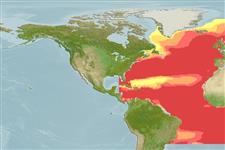Environment: milieu / climate zone / depth range / distribution range
Ecologia
marinhas batipelágico; intervalo de profundidade 100 - 1800 m (Ref. 87004), usually 100 - 1100 m (Ref. 87004). Subtropical; 75°N - 25°S, 85°W - 0°W
Distribuição
Países | Áreas FAO | Ecossistemas | Ocorrências | Point map | Introduções | Faunafri
Atlantic Ocean: From Iceland to Brazil and Guinea Gulf, from Caribbean to West Africa.
Tamanho / Peso / Idade
Maturity: Lm ? range ? - ? cm
Max length : 11.0 cm SL macho/indeterminado; (Ref. 123983)
Descrição breve
Chaves de identificação | Morfologia | Morfometria
Espinhos dorsais (total) : 7 - 8; Raios dorsais moles (total) : 10 - 11; Espinhos anais: 3; Raios anais moles: 7 - 8; Vértebras: 24 - 26. 3 scale rows under the D2 origin down to the lateral line, 10-11 (rarely 12-13) in total. 14-15 pelvic fin rays, rarely 16.
Individuals 7.5 cm SL and longer mostly occur in the boreal areas, while those less than this the length occur in the tropical areas (Ref. 87004). Maximum length reported in Ref. 87004: 11 cm TL.
Life cycle and mating behavior
Maturities | Reprodução | Spawnings | Egg(s) | Fecundities | Larvas
Santos, R.S., F.M. Porteiro and J.P. Barreiros, 1997. Marine fishes of the Azores: annotated checklist and bibliography. Bulletin of the University of Azores. Supplement 1. 244 p. (Ref. 35204)
Categoria na Lista Vermelha da IUCN (Ref. 130435)
Ameaça para o homem
Harmless
Utilização humana
Ferramentas
Relatórios especiais
Descarregue XML
Fontes da internet
Estimates based on models
Preferred temperature (Ref.
123201): 1.7 - 18.6, mean 7.7 °C (based on 1396 cells).
Phylogenetic diversity index (Ref.
82804): PD
50 = 0.5176 [Uniqueness, from 0.5 = low to 2.0 = high].
Bayesian length-weight: a=0.01000 (0.00244 - 0.04107), b=3.04 (2.81 - 3.27), in cm total length, based on all LWR estimates for this body shape (Ref.
93245).
Nível Trófico (Ref.
69278): 3.4 ±0.4 se; based on size and trophs of closest relatives
Resiliência (Ref.
120179): Médio, tempo mínimo de duplicação da população 1,4 - 4,4 anos (Fecundity assumed < 1000).
Fishing Vulnerability (Ref.
59153): Low vulnerability (10 of 100).
